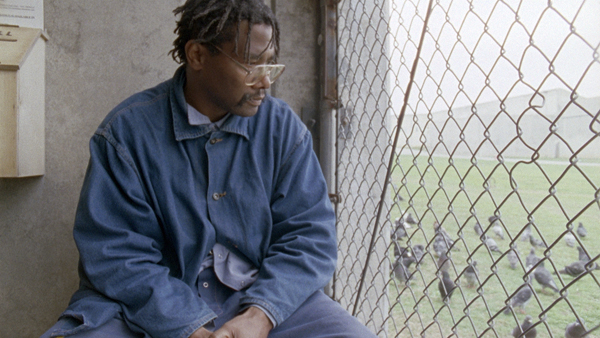At Night I Fly: Images from New Folsom takes a special and remarkable journey into one of California’s maximum security prisons. The film is ostensibly about Arts in Corrections (AIC), a California prison program that began in 1977. It was discontinued in 2010 due to the state’s budget crisis. AIC was, for many years, the largest prison arts program in the world. Community artists came into each penitentiary to share the tools of art-making with the men and women, many of whom were serving life sentences.
From the opening images of a fuzzy bird flying in the air with the audio of static noise from guards’ walkie-talkies, this film is unique. It doesn’t try to explain. It doesn’t proselytize. It doesn’t even try to promote AIC. There are no glowing reports of the program from guards, administrators, teachers, or men showing their art proudly. The inmates recite poetry, talk about their experience, and the filmmakers simply film what is.
If you’ve never been in a prison you might be impatient and think the film is slow and wonder what the point is. You’ll think an opening shot of the man sitting on his bunk bed is a photographic still. It’s not. The camera lingers longer than is comfortable, and then this man moves and you realize he’s being filmed. It’s just that time inside is slow, so the film takes its time, too.
Men file out into a yard and are frisked by guards. Men are sitting in wire mesh cages smaller than a telephone booth. Men are mopping a floor. The offices are dreary, the control towers bleak, the cells and the yard ugly, the sounds stark and static. “This place serves no other purpose but containment. It’s about isolation; closure of mind and heart and spirit. It’s a cold that sucks out the heat,” Marty, one of the men, tells us.
Amidst all of this we hear a haunting and beautiful melody, and the camera shows us a man standing in a corner playing a flute. Poetry becomes the voice-over. How did this happen? We are transported and recognize the beauty of the moment and, indeed, the value of it.
There’s little hope (many of the men have sentences of life without the possibility of parole), and the film reveals how an individual responds to the isolation and dehumanization, how he comes to terms with his existence—past, present and future—is key. At Night I Fly poses the question, if there are no opportunities to explore one’s self, one’s creative expression, to get out of any box one is in literally or figuratively, what is left? “Arts,” another man says, “bring about a conduit for communication. It breaks down barriers. Arts are a lifeline to sanity.”
Given the context of the extreme racial segregation, perhaps one of the most amazing moments captures a mixed race group of men passionately talking about race. A white man talks about his struggle to say hello or shake the hand of a black man and not care what other people think about it, and others explore what it means to be in a room together and how to take that out onto “the yard.” That we are witness to this is groundbreaking.
It’s extremely rare for the public to have an in-depth view of a maximum security—or, indeed, any prison. Anyone who has been inside knows what an unusual occurrence it is for the public to see the reality of a racially tense and segregated yard, footage of riots, and men in their isolation “exercise yards” walking in circles, much less to see and hear prisoners speaking in their own words. The public may know very little about these men’s lives. This film changes that.
For more information on the actual Arts in Corrections program, read Larry Brewster’s book Paths of Discovery: Art and Practice and Its Impact in California Prison, published by CreateSpace, 2012. Included are statistics as to its success in reducing recidivism, along with writings, art and interviews with inmates reflecting upon their learning and growth.







Great film but, the first prison related reality show happened in Canada where a group of prisoners headed by a local television producer, produced the contact show that eventually went live. Canada corrections unparalleled anywhere in the world, allowed this particular crew access to all security levels in a variety of prisons from max to community halfway houses and access to government official all the way to the justice. minister. Again any news about the reality of prison is a good thing, it is through correct knowledge that a person vote can be correctly placed to change their world,
The Contact show…WWW.prisontv.net